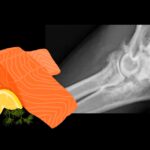We were wrong.
For years.
But when you know better, you do better.
For decades, North American vets recommended every pet be spayed and neutered, and usually before 6 months of age.
Why? To prevent unwanted litters. And we know neutered pets live longer.
It was a simple, easy to follow rule. Almost a no–brainer.
It turns out it was too easy.
We have studies now that look at how the timing of spay and neuter surgeries affects disease rates in different breeds of dogs.
Once we start peeling back the layers of our nice easy “one size fits all” rule, we see the true complicated reality. Unfortunately, even truly life-changing knowledge takes a long time to be widely known and accepted, especially when it goes against a widely accepted dogma.
A study on Golden Retrievers in 2013 started the ball rolling. Amazing and beautiful dogs, but they suffer from many health conditions. This study revealed a dramatic relationship between joint problems, cancers, and the timing of when they were neutered or spayed.
Now, I know not all of you reading this have Golden Retrievers, or even puppies or kittens right now—but don’t immediately put this email in the trash. Indulge me for a few minutes please.
“Why should I care?”
I want to show you:
1. We get a lot of things wrong– what we know for sure today may be proven incorrect in the future. This is true in human medicine also. Be wary of simple dogma.
2. Many things are way more complicated than we would like them to be, but simple one size fits all answers end up harming individual pets.
3.There are always trade-offs—when we lessen a risk with one change, we may increase the risk of something else.
Even if you don’t have a puppy now, what you’ll learn about spay/neuter timing could save your future pet from painful joint disorders and cancer. And please share with a friend!
Here is a quick primer on the types of disorders that are most affected by spay and neuter surgeries, which remove the sex hormones.
Joint Disorders
- Hip Dysplasia (HD)– abnormal development of the hip joint, leading to a loose, lax joint and eventual arthritis
- Cranial Cruciate Ligament Rupture (CCLR)- tear of the cruciate ligament in the knee joint, often requires surgery to repair, always leads to arthritis, pain and disability
Cancers
- Lymphosarcoma (LSA)– cancer of white blood cells
- Hemangiosarcoma (HSA)– cancer of blood vessels that usually starts with a tumor in the spleen or heart.
- Mast Cell Tumour (MCT)- cancer of immune system mast cells ( those involved in allergic reactions), usually in the skin.
- Mammary Tumors- cancer of the mammary glands in females
- Brain tumors
Intervertebral Disk Disease
This degeneration of the intervertebral discs between boney vertebrae leads to rupture of the disc, and pressure on the spinal cord causing pain and even paralysis. Dachshunds have a genetic predisposition to this condition and are at extreme risk.
Urinary Incontinence
Female dogs can be incontinent when they lack estrogen, after a spay surgery.
Accelerated Brain Aging
Progressive structural and functional changes in the brain over time, seen more in post-menopausal women and spayed female dogs (study). Estrogen may have a neuroprotective effect.
The Golden Study
The Golden Retriever study revealed a clear cut effect on joint disorders.
Cranial Cruciate Ligament Rupture in the Stifle Joint
Zero intact (not spayed or neutered) Golden Retrievers had a CCL Rupture.
Zero.
In dogs spayed or neutered before 1 year of age (early neutered):
- 5% incidence in males
- 7.7 % for females
Hip Dysplasia
The incidence of HD doubles for early neutered male dogs compared to intact males. For females, the difference wasn’t significant.
Why do we see increased joint disorders for Goldens sterilized early?
Bones grow longer from growth plates in puppies and kittens.
Hormones-especially the sex hormones estrogen and testosterone—tell the bones when to stop growing. When dogs are neutered before their bones finish growing we take away these hormones prematurely, essentially removing the signal for the bones to stop growing.
The bones become longer than normal, leading to altered joint geometry. Lack of these hormones also affects ligament strength.
If you subject weak ligaments to altered biomechanical forces—you get a torn cruciate ligament inside the knee joint. You also get abnormally lax hip joints.
I could end this section here, leave it at some matter-of-fact dry numbers— 5% more, 7.7% more, risk doubles—but I have to tell you what this truly represents and why it matters.
CCLR’s are the most common cause of hind limb lameness in dogs. As a vet for 17 years, I can’t count the number of dogs I diagnosed with this condition.
It is always very painful for them. It is often difficult for the owner to decide if they can, or should, spend thousands on surgery to repair the knee, hoping for a return to full function.
Those knees always develop arthritis. Always.
There are inevitable years of pain ahead for those dogs. And I saw it as soon as they walked in the door, barely putting any weight on that back leg.
When I realize now that it could have been prevented, and that my recommendations could have contributed…
It weighs heavy.
Do the best you can until you know better. Then when you know better, do better.
– Maya Angelou
So here I am, trying to do better, one newsletter at a time. If this information could help prevent even one case of painful joint disease, please share it with someone who has a large breed puppy or is considering one.
Joint Disorders in Other Breeds
Many other large breed dogs show a similar pattern. Early sterilization leads to increased risk of HD and CCLR (study).This is true for dogs over 20 kg , especially Labrador Retrievers, German Shepherds, Rottweilers, and Bernese Mountain dogs and large mixed breeds.
Dogs under 20 kg are not affected by this dramatic effect. This is likely because they have less stress and forces on joints due to a smaller body weight, and their skeletons mature earlier than large dogs.
Cancers
We know that neutering increases the lifespan of pets, and they die from less infectious disease, trauma and reproductive problems. But more neutered dogs are dying from cancers.
The study of cancers in Golden Retrievers reveals the complex relationship between the role of hormones in cancer and the timing of removal.
For males, neutering before 12 months triples the risk of lymphosarcoma compared to intact males.
Female Goldens show a different pattern. They experience a modest increase in lymphosarcoma with spaying, but the dramatic finding relates to late-spayed females (spayed after multiple heat cycles).
Late-spayed females face four times greater risk of hemangiosarcoma and develop mast cell tumors at a rate of approximately 6%, while intact females showed no occurrence of MCT at all.
This unexpected increase in cancer after late spaying appears to stem from the complex role of estrogen in cancer development. Estrogen sensitizes certain cellular pathways to potential cancer formation while simultaneously providing protection against tumor development. When females experience several heat cycles, these pathways become sensitized to estrogen. Later, when spaying removes the estrogen’s protective effects, these sensitized cells lose their defense mechanism and often become cancerous.
When we look at other breeds, we see some breeds have higher risk of cancer.
- Boxers- 2-4 X increase risk of cancer with sterilization, increased risk of faster brain aging and increase in brain tumors.
- Rottweilers- risk of osteosarcoma (bone cancer) increased about 3 X for those neutered before 1 year
- Doberman Pinscher- increased risk of cancer in males neutered at any time.
- Vizlas, Standard Poodles and Border Collies– various increased risk
Cancer Risk in Small Dogs
Small dog cancer risk is very much less affected by neuter timing, with the exception of female Shih Tzus and male Boston Terriers—both having increased risk of cancers if neutered before a year.
One of the main arguments to spay females before the first heat is the prevention of mammary cancer. It was thought that the risk of these tumors was quite high in intact or later spayed females, but a recent published review paper looked at 13 studies found the evidence of a protective effect weak.
Intervertebral Disk Disease in Dachshunds
This breed and disorder will forever live together in infamy, and haunt may a vet’s dreams. Dachshunds and Intervertebral Disk Disease go together like Bonnie and Clyde, Ben and Jerry…
Intact males and females already have a huge risk of this disease within their lifetime ( around 50%!), but neutering increases this risk, and early neutering especially so. Corgis also have a moderate increased risk with neutering.

Urinary Incontinence
The Doberman Pinscher is at very high risk- 25% of females spayed before 6 months developed UI, and 19% develop it when spayed between 1-2 years.
Brain Aging and Brain Cancers
Spayed female dogs have an 11-fold increased risk of brain tumors compared to intact females. The brains of Boxer dogs and spayed females age more quickly than intact dogs.
The Takeaway:
“One size fits all” rules don’t work anymore—we can do better.
TL;DR
Small breed dog?
Timing is really only critical for Dachshunds, Corgis, Boston Terriers, Cocker Spaniels and Shih Tzus—with our current knowledge.
Medium, large and giant breed dog?
In general, early neutering will increase the risk of joint problems for many, but not all, breeds—delaying the spay or neuter until after maturity helps to lessen this risk.
This comes with trade-offs, sometimes in the form of increased risks of cancer.
Breeds that really deserve close scrutiny and a lot of thought put into the decision are Golden Retrievers, Rottweilers, German Shepherds, Boxers, Doberman Pinschers, Collies.
In the case of female Golden Retrievers and male Doberman Pinschers, the recommendation of the researchers was to leave these animals intact.
Given the study in Boxers on increased risk (11 X higher!) of brain tumors and accelerated brain aging, I would urge Boxer owners to think very carefully about spaying females.
The decision about when—or whether—to sterilize your pet is more nuanced than we once thought and requires careful consideration of many factors.
Armed with this knowledge, you can be a valuable advocate for your pet.
Grab a copy of the guide I created—based on over 20 recent scientific studies—to help with the decision. It is a PDF that can be printed brought to your vet. The studies are all listed for those that want to dig deeper!





